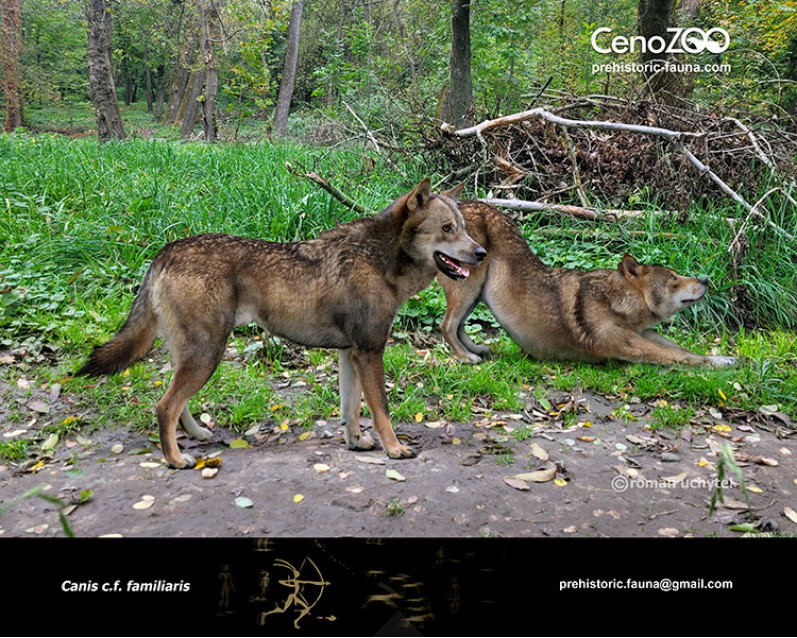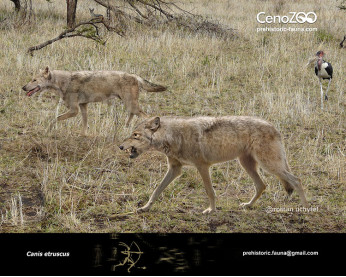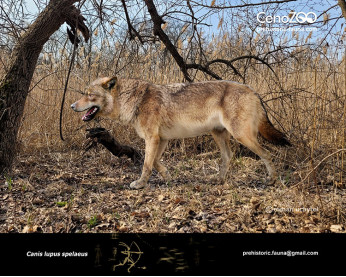Paleolithic dog
2843028430
Paleolithic dog (Canis c.f. familiaris/Canis lupus domesticus)
Order: Carnivora
Family: Canidae
Temporal range: during the late Pliocene - Early Pleistocene (Europe)
Dimensions: length - 1,3 m, height - 70 сm, weight - 36–40 kg
The Paleolithic dog was a Late Pleistocene canine. They were directly associated with human hunting camps in Europe and Asia over 30,000 years ago and it is proposed that these were domesticated. They are further proposed to be either a proto-dog and the ancestor of the domestic dog or an extinct, morphologically and genetically divergent wolf population.
That dog was smaller than the extant grey wolf (Canis lupus), with a skull size to the modern large dog breeds. The Paleolithic dog had a mean body mass of 36–37 kg compared to recent European wolf 41–42 kg.
The earliest sign of domestication in dogs was thought to be the neotenization of skull morphology and the shortening of snout length. This leads to tooth crowding, a reduction in tooth size and the number of teeth, which has been attributed to the strong selection for reduced aggression.
Compared with the Pleistocene and modern wolves, the Paleolithic dog had a shorter skull length, a shorter face length, and a wider snout. The snout width was greater than those of both the Pleistocene and modern wolves, and implies well-developed carnassials driven by powerful jaws. In two morphometric analyses, the nearest dog skull-shape that was similar to the Paleolithic dog was that of the Central Asian Shepherd Dog.
Оплата
У Вас є кілька зручних способів купівлі зображення: кредитна чи дебетова картка Visa, Mastercard, Maestro; PayPal або банківський переказ
Paleolithic dog (Canis c.f. familiaris/Canis lupus domesticus)
Order: Carnivora
Family: Canidae
Temporal range: during the late Pliocene - Early Pleistocene (Europe)
Dimensions: length - 1,3 m, height - 70 сm, weight - 36–40 kg
The Paleolithic dog was a Late Pleistocene canine. They were directly associated with human hunting camps in Europe and Asia over 30,000 years ago and it is proposed that these were domesticated. They are further proposed to be either a proto-dog and the ancestor of the domestic dog or an extinct, morphologically and genetically divergent wolf population.
That dog was smaller than the extant grey wolf (Canis lupus), with a skull size to the modern large dog breeds. The Paleolithic dog had a mean body mass of 36–37 kg compared to recent European wolf 41–42 kg.
The earliest sign of domestication in dogs was thought to be the neotenization of skull morphology and the shortening of snout length. This leads to tooth crowding, a reduction in tooth size and the number of teeth, which has been attributed to the strong selection for reduced aggression.
Compared with the Pleistocene and modern wolves, the Paleolithic dog had a shorter skull length, a shorter face length, and a wider snout. The snout width was greater than those of both the Pleistocene and modern wolves, and implies well-developed carnassials driven by powerful jaws. In two morphometric analyses, the nearest dog skull-shape that was similar to the Paleolithic dog was that of the Central Asian Shepherd Dog.


-797x638.jpg)

-70x56.jpg)



-346x277.jpg)